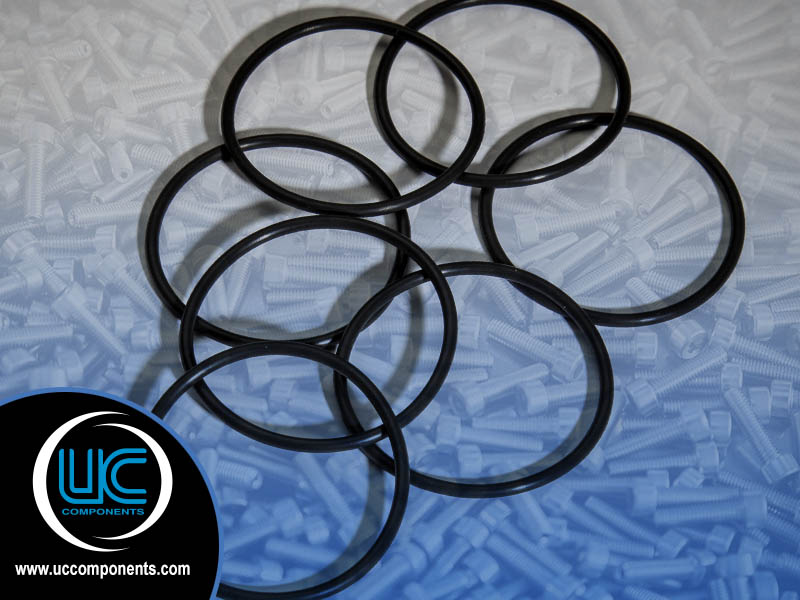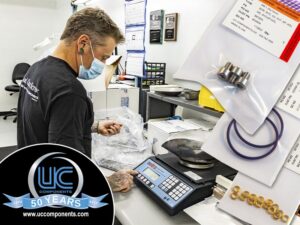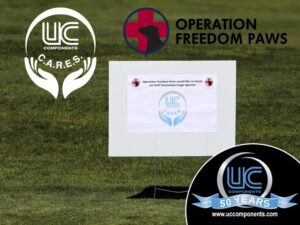Fluoroelastomer, FKM, FPM, and Viton® are all different names for the same synthetic rubber material family. There are even more names for this material than we have listed here, these are simply the most common names. Why does the same material have so many different names?
Here is what each of those names means:
- Fluoroelastomers are a family of fluoropolymer rubbers.
- FKM is the American standard (ASTM) short form name for Fluoroelastomers or fluoro rubber material. F stands for Fluoro; the K is an abbreviation of the German word Kohlenstoff, meaning Carbon; and the M is the designation of saturated backbone rubber from ASTM.
- FPM is the international ISO 9000 and ISO/TS 16949 standard registration for Fluoroelastomers.
- Viton® is a registered trademark of DuPont Performance Elastomers LLC. Back in 1958 they developed this compound to meet the stringent requirements of the aerospace industry for a higher-performing elastomer. The use of the material quickly spread to other industries such as automotive, chemical, and fluid power industries.
This highly fluorinated carbon-based polymer is divided into five classes based on chemical composition, fluorine content, or their cross-linking mechanism. Fluoroelastomers with higher fluorine content have increasing fluid resistance as the fluorine levels go up.
Like most elastomers, Fluoroelastomers are composed of multiple monomers. Specifically, there are six major monomers used to create the various types of Fluoroelastomers:
- Ethylene (E)
- Hexafluoropropylene (HFP)
- Perfluoro Methyl Vinyl Ether (PMVE)
- Propylene (P)
- Tetrafluoroethylene (TFE)
- Vinylidene Fluoride (VDF)
This chart gives a quick overview of these monomers and type of Fluoroelastomers:
| Fluorine Content | Monomers in straight chain segments | Monomers with bulky side groups | Examples | |||||
| VDF | TFE | E | HFP | PMVE | P | CSM | ||
| 66% | X | X | Viton A | |||||
| 66-70% | X | X | X | Viton B, F, AL | ||||
| 65.5-70% | X | X | X | X | Viton GAL-S, GBL-S, GF-S | |||
| 64.5-67% | X | X | X | X | Viton GLT-S, GBLT-S, GFLT-S | |||
| 66% | X | X | X | X | Viton ETP-S | |||
| 60% | X | X | X | Viton TBR-S, Aflas 100 | ||||
| 60% | X | X | X | X | Aflas 200 | |||
| 70-74% | X | X | X | Perfluoroelastomer |
Fluoroelastomers have extraordinary resistance to most fluids at high temperatures. The material can withstand extreme temperatures with a useful service life above 473°F/225°C, chemicals, heat, and oil. For these reasons, Fluoroelastomer has become one of the most widely used materials to create O-rings and seals. The material’s composition of monomers can be customized to provide a boost to its attractive properties, changes such as:
- Improved temperature resistance (both low and high)
- Good oil and grease resistance
- Excellent resistance to aggressive oxidation, acids, fuels, or chemicals
- Good resistance to extreme environments
- Low compression set
- Low gas absorption rate
- And more
Though, keep in mind that all types typically have limited resistance to methanol, hot water (above 212°F or 100°C), steam, and other highly polar fluids. The other main drawback of this family of materials is its intolerance to low temperatures (limit of -22°F or -30°C).
What are Fluoroelastomers used for?
This family of materials is used in a variety of industries such as automotive, semiconductor manufacturing, air transportation, medical, food manufacture, chemical processing, power generation, and many more.
Here are a few popular industries that utilize Fluoroelastomers and how they are used:
| Industry | Application |
| Aerospace | O-rings and seals used in auxiliary power units, connectors, line fittings, hydraulic actuators, pumps, valves, oil reservoirs, and more. |
| Automotive | O-rings and seals used in fuel injection, head, and intake manifolds, and more. |
| Industrial | O-rings and seals used in oil and gas systems, pumps, valves, tanks, heat exchange equipment, and more. |
| Semiconductor | Wafer fabrication |
Fluoroelastomers can be fabricated into O-rings, seals, hoses, and so much more for a variety of industries. These polymers enhance sealing reliability, safety, and prevent material leakages in a range of high-performance applications.
UC Components, Inc. can help!
UC Components, Inc. RediVac® O-rings are specially processed for use in critical applications. Our standard O-rings are manufactured from top quality fluoroelastomer materials. Buna, silicone, and other materials are available upon request. Specific chemistries may also be available upon request.
All of our O-rings are cleaned and packaged in our certified Class 100/ISO Class 5 Cleanroom, making them suitable for immediate use in most HV, UHV, EUV, or other clean-critical applications. Vacuum baked O-rings are available for reduced outgassing under vacuum.
UC Components, Inc. has been the world leader in high vacuum hardware since 1974. We specialize in O-rings and fasteners for High Vacuum, Ultra High Vacuum, and other critical applications. View our parts catalog online to find the components you need, request a quote, or contact us for more assistance or additional information.



